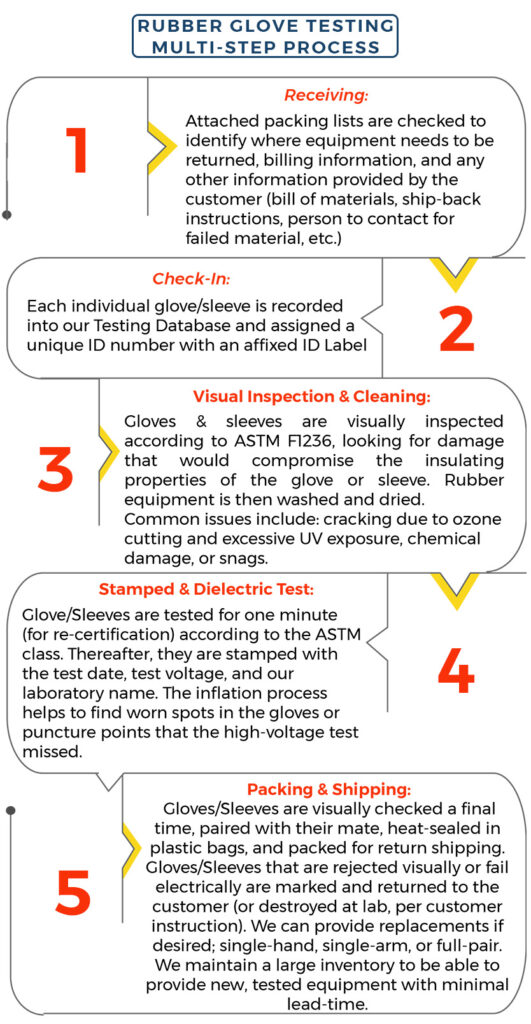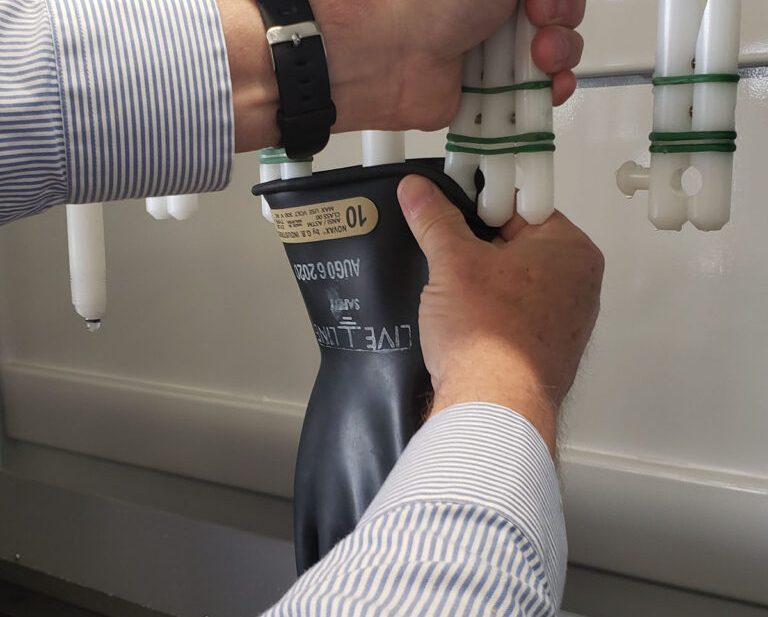- April 4, 2022
- by Toby
- Rubber Glove Testing
The average yearly fatality rate for power line workers is 56 deaths per 100,000 employees, according to the National Institute for Occupational Safety and Health. A variety of personal protection equipment (PPE) components should be used in the field to keep workers safe. Rubber goods are one of the most critical lines of defense.
Taking a few basic steps with your rubber goods can substantially lessen the chance of damage, and even death, from electric shock. Maintain daily inspections and cleaning, adopt safe storage procedures, and get your equipment safety tested at an experienced, accredited testing lab on a regular basis.
Learn why rubber goods are so crucial for worker safety and how to make sure your equipment is up to the task.
Why Rubber Goods?
In addition to regular care and maintenance, adhering to ASTM standards reduces the risk of injury in the field. Even better, it makes users and their businesses OSHA compliant. This keeps workers safe and lowers the likelihood of an OSHA fine. Rubber goods should be sent to a top-quality, NAIL for PET-accredited rubber testing facility in addition to daily inspection, proper storage, and care. Equipment is tested and recertified at these facilities to ensure compliance with ASTM standards (ASTM 478-09, 7.1, F479-06, 8.1.1, and F496-08, 7.1).
Rubber gloves should be electrically tested before their first use and every six months thereafter, according to ASTM F496, 7.1. Sleeves, line hose, blankets, and hoods all have their own testing cycles. The end user determines cycle dates, but ASTM mandates maximum testing intervals. All ASTM codes are available for review on the internet.

Gulf Coast Calibration Testing Steps
Having the proper equipment and processes in place is the first step toward maintaining a safe work environment. When selecting rubber goods, pay close attention to detail and quality control. Outsourcing rubber goods testing can be beneficial in terms of convenience and peace of mind. High-quality rubber goods testing includes the following steps:
- Cleaning
- Visual inspection
- Electrical testing
- Certification
- Date stamping
- Packing
- Shipping
Cleaning
A NAIL for PET-accredited test lab cleans the outside and inside of all rubber goods. The lab removes old stamps and dirt. The goods are then allowed to completely dry before being subjected to a visual inspection by a trained inspector (ASTM 1236-96). Cleaning rubber goods properly removes conductive and compromising dirt and oil while allowing for the best visual inspection.
Visual inspection.
While rubber goods may appear to be safe, inflating or rolling them can reveal hidden damage. The rubber is inflated, inspected, turned inside-out, inflated, and inspected again during visual inspection of gloves and sleeves. Blankets are rolled carefully and scanned on both sides. Line hoses are unrolled and then rolled.
Inflation and rolling improve the scan of the rubber. It also highlights physical flaws. If the rubber has any scratches, punctures, or cracking, it does not pass visual inspection and will not proceed to the next step.
Electrical testing.
Electrical testing of rubber encompasses exposing the rubber to an electrical voltage. The voltage is determined by the rubber’s class (ASTM F496: Section 7). Rubber is electrically tested beyond its maximum field use to ensure that it can withstand the electrical stress that it will face while in use.
If there is an electrical failure, a hole will be burned through the rubber. Because the item is unfit for electrical use, it is labeled as a failure.
Certification, Date Stamping, Packing and Shipping.
After passing the visual and electrical tests, the rubber is certified with a date stamp. This stamp includes the test date or expiration date, the voltage at which the PPE was tested, and the name of the testing facility. Stamping is done with a special ink. It is safe to use on rubber and will not fade or wipe off under normal conditions.
After the stamps have dried, the gloves and sleeves are dusted with talc powder to absorb any remaining moisture (ASTM F478, F479 and F496). The gloves and sleeves are then heat sealed in new plastic bags. Blankets and line hose are securely stored in plastic bins or totes. When the goods are packaged, great care is taken to ensure that they are not crushed or folded. Plastic totes are recommended for shipping because they provide solid protection while in transit.
Are your rubber goods ensuring the safety of your employees?
This question is easily answered due to the regular testing of rubber goods. Testing does more than just bring your facility up to code. It protects employees from potentially fatal situations. Take a few moments to inspect your equipment so that you are properly protected from any electrical hazards.

